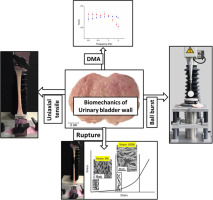Journal of the Mechanical Behavior of Biomedical Materials ( IF 3.3 ) Pub Date : 2017-11-28 , DOI: 10.1016/j.jmbbm.2017.11.034 Maryam Sami Jokandan , Fatemeh Ajalloueian , Magnus Edinger , Peter Reimer Stubbe , Stefania Baldursdottir , Ioannis S. Chronakis

|
Regenerative medicine for reconstructive urogenital surgery has been widely studied during the last two decades. One of the key factors affecting the quality of bladder regeneration is the mechanical properties of the bladder scaffold. Insight into the biomechanics of this organ is expected to assist researchers with functional regeneration of the bladder wall. Due to extensive similarities between human bladder and porcine bladder, and with regard to lack of comprehensive biomechanical data from the porcine bladder wall (BW), our main goal here was to provide a thorough evaluation on viscoelastic properties of fresh porcine urinary BW. Three testing modes including Uniaxial tensile, ball-burst (BB) and Dynamic Mechanical Analysis (DMA) were applied in parallel. Uniaxial tests were applied to study how different circumferential and longitudinal cut-outs of lateral region of BW behave under load. DMA was used to measure the viscoelastic properties of the bladder tissue (storage and loss modulus) in a frequency range of 0.1–3 Hz. BB was selected as a different technique, replicating normal physiological conditions where the BW is studied in whole. According to uniaxial tests, the anisotropic behavior of bladder is evident at strain loads higher than 200%. According to DMA, storage modulus is consistently higher than loss modulus in both directions, revealing the elasticity of the BW. The stress-strain curves of both uniaxial and BB tests showed similar trends. However, the ultimate stress measured from BB was found to be around 5 times of the relevant stress from uniaxial loading. The ultimate strain in BB (389.9 ± 59.8) was interestingly an approximate average of rupture strains in longitudinal (358 ± 21) and circumferential (435 ± 69) directions. Considering that each testing mode applied here reveals distinct information, outcomes from the combination of the three can be considered as a helpful data-base to refer to for researchers aiming to regenerate the bladder.
中文翻译:

膀胱壁生物力学:新鲜猪膀胱的综合研究
在过去的二十年中,用于重建性泌尿生殖外科手术的再生医学得到了广泛的研究。影响膀胱再生质量的关键因素之一是膀胱支架的机械性能。深入了解该器官的生物力学有望帮助研究人员实现膀胱壁的功能性再生。由于人膀胱与猪膀胱之间的广泛相似性,并且由于缺乏来自猪膀胱壁(BW)的综合生物力学数据,我们的主要目标是对新鲜猪尿BW的粘弹性进行全面评估。并行应用了三种测试模式,包括单轴拉伸,球爆(BB)和动态力学分析(DMA)。单轴测试用于研究在负载下BW侧面区域的不同圆周和纵向切口的行为。DMA用于在0.1–3 Hz的频率范围内测量膀胱组织的粘弹性(存储和损耗模量)。选择BB作为另一种技术,可以复制正常的生理条件,对整个BW进行研究。根据单轴测试,在高于200%的应变载荷下,气囊的各向异性行为非常明显。根据DMA,储能模量在两个方向上始终高于损耗模量,从而揭示了BW的弹性。单轴和BB试验的应力-应变曲线都显示出相似的趋势。但是,从BB测得的极限应力约为单轴载荷相关应力的5倍。有趣的是,BB的最终应变(389.9±59.8)是纵向(358±21)和圆周(435±69)方向的破裂应变的近似平均值。考虑到此处采用的每种测试模式都可以揭示不同的信息,因此可以将这三种方法的结合结果作为有用的数据库,以供旨在使膀胱再生的研究人员参考。











































 京公网安备 11010802027423号
京公网安备 11010802027423号